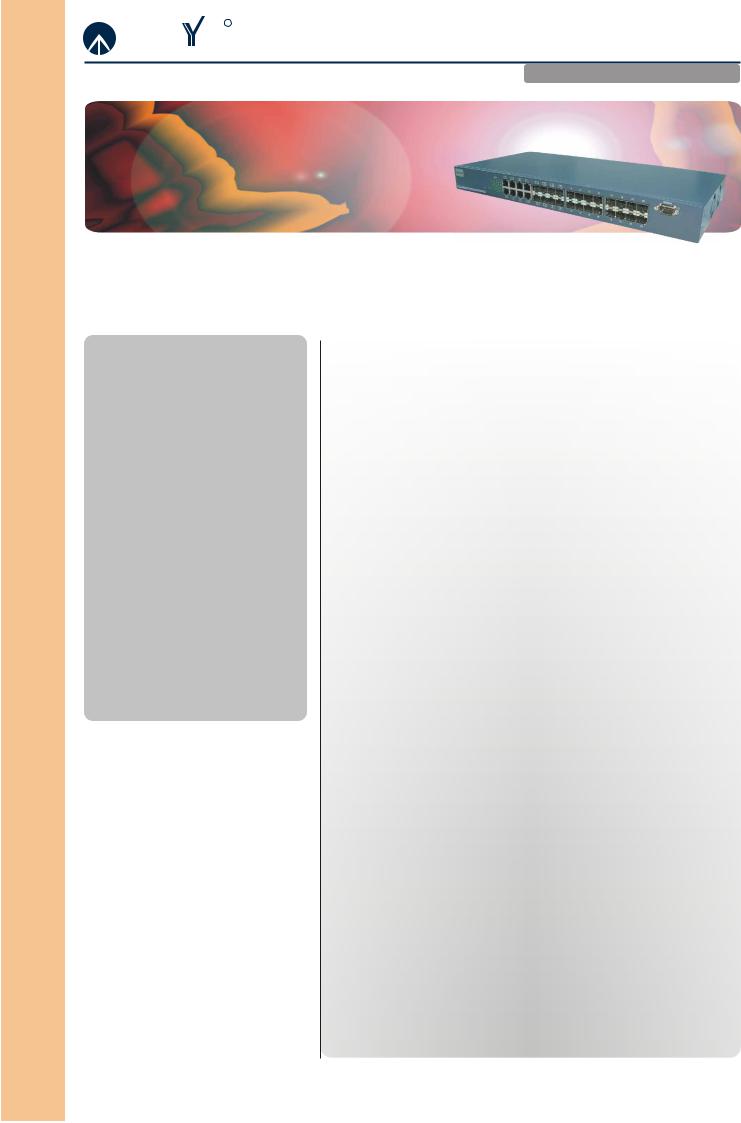Ruby Tech FGS-2924R User Manual

Switch Gigabit
RUB TECH |
R |
|
Gigabit Switch |
||
Networking & Communications |
L2 Plus Managed Switch
FGS-2924R
FGS-2924R:
16-Port SFP + 8-Port Combo GbE L2 Plus Managed Switch
Key Features
 24-Port Gigabit SFP High Port Count
24-Port Gigabit SFP High Port Count
Fiber Switch
 9KB Jumbo Frame Support
9KB Jumbo Frame Support
 IEEE 802.1x Access Control Improve
IEEE 802.1x Access Control Improve
Network Security
 Port Mirroring Helps Supervisor
Port Mirroring Helps Supervisor
Monitoring Network
 Q-in-Q VLAN for performance & security and 4094 Vlan entries(prevision, upgrade via FW)
Q-in-Q VLAN for performance & security and 4094 Vlan entries(prevision, upgrade via FW)
 IEEE 802.1D Compatible, 802.1w Rapid
IEEE 802.1D Compatible, 802.1w Rapid
Spanning Tree and 802.1s Multiple
Spanning Tree
 Unknown Unicast/Broadcast/Multicast
Unknown Unicast/Broadcast/Multicast
Storm Control
 Multicast Vlan Management for IPTV
Multicast Vlan Management for IPTV
 IP-Mac-Port binding for LAN security
IP-Mac-Port binding for LAN security
 QCL Based on Application traffic for QoS and rate limitation management
QCL Based on Application traffic for QoS and rate limitation management
 ACL Based on Ethernet Type / ARP / IPv4 for packets permit or deny, rate limitation and port copy
ACL Based on Ethernet Type / ARP / IPv4 for packets permit or deny, rate limitation and port copy
 DHCP Option 82 relay agent
DHCP Option 82 relay agent
Overview
FGS-2924R, a 24-port Gigabit L2 Plus Managed Switch, is a standard switch that meets all IEEE 802.3/u/x/z Gigabit, Fast Ethernet specifications. The switch includes 16-Port 1000Mbps SFP and 8-Port Combo Gigabit TP/SFP Fiber dual media management Ethernet switch. The switch can be managed through RS-232 serial port, or through Ethernet port using CLI or Web-based management unit, associated with SNMP agent. With the SNMP agent, the network administrator can logon the switch to monitor, configure and control each port's activity in a friendly way. The overall network management is enhanced and the network efficiency is also improved to accommodate high bandwidth applications. In addition, the switch features comprehensive and useful functions such as QoS (Quality of Service),
Benefits
 QoS with four priority queues
QoS with four priority queues
The QoS(Quality Of Service) Control List (QCL) feature provides four internal queues to support four different classifications of traffic. High priority packet streams experience less delay inside the switch, which supports lower latency for certain delay-sensitive traffic. The
FGS-2924R can classify the packet as one of the four priorities according to vip port, 802.1p priority tag, DiffServ and/or IP TOS, IPv4 and UDP/TCP application traffics. The QoS operate at full wire speed. The actual scheduling at each egress port can be based upon a strict priority, weighted round robin or a mix of both.
 Port Mirroring
Port Mirroring
It is based on ACL function to classify the ingress traffic to do port copy. This mechanism helps track network errors or abnormal packet transmission without interrupting the flow of data. Allow ingress traffic to be monitored by a single port that is defined as mirror capture port. The mirror capture port can be any 10/100 port, 10/100/1000 port. Mirroring multiple ports is possible but can create congestion at the mirror capture port.
 Q-in-Q VLAN for performance & security
Q-in-Q VLAN for performance & security
(prevision, upgrade via FW)
The VLAN feature in the switch offers the benefits of both security and performance. VLAN is used to isolate traffic between different users and thus provides better security. Limiting the broadcast traffic to within the same VLAN broadcast domain also enhances performance. Q-in-Q, the use of double VLAN tags is an efficient method for enabling Subscriber Aggregation. This is very useful in the MAN.
 Isolated Group, provides protection for certain ports
Isolated Group, provides protection for certain ports
The isolated group feature allows certain ports to be designated as protected. All other ports are non-isolated. Traffic between isolated group members is blocked. Traffic can only be sent from isolated group to non-isolated group.
 Mac-based 802.3ad LACP with automatic link fail-over
Mac-based 802.3ad LACP with automatic link fail-over
Dynamic fail-over means packets will not get assigned to any trunk member port that has failed. If one of the ports were to fail, traffic will automatically get distributed to the remaining active ports.
 802.1x Access Control improves network security
802.1x Access Control improves network security
802.1x features enable user authentication for each network access attempt. Port security features allow you to limit the number of MAC addresses per port in order to control the number of stations for each port. Static MAC addresses can be defined for each port to ensure only registered machines are allowed to access. By enabling both of these features, you can establish an access mechanism based on user and machine identities, as well as control the number of access stations.
 802.1d Compatible & 802.1w Rapid Spanning Tree
802.1d Compatible & 802.1w Rapid Spanning Tree
For mission critical environments with multiple switches supporting

Switch Gigabit
R
RUB TECH
Networking & Communications |
Gigabit Switch |
|
|
L2 Plus Managed Switch |
|
Spanning Tree, VLAN, Port Trunking, |
STP, you can configure the switches with a redundant backup bridge |
|
Bandwidth Control, Port Security, SNMP/ |
path, so transmission and reception of packets can be guaranteed in |
|
RMON, IGMP Snooping capability via the |
event of any fail-over switch on the network. |
|
intelligent software. It is suitable for both |
8 dual media ports for flexible fiber connection |
|
metro-LAN and office applications. |
8-Port dual media ports are provided for flexible fiber connection. You |
|
|
can select to install optional transceiver modules in these slots for |
|
|
short, medium or long distance fiber backbone attachment. Use of the |
|
|
SFP will disable their corresponding built-in 10/100/1000Base-T |
|
|
connections. |
|
|
Broadcast/Multicast/unknown-unicast Storm Control |
|
|
To limit too many broadcast/multicast/unknown-unicast flooding in the |
|
|
network, broadcast/multicast storm control is used to restrict excess |
|
|
traffic. Threshold values are available to control the rate limit for each |
|
|
port. Packets are discarded if the count exceeds the configured upper |
|
|
threshold. |
|
|
IP-MAC-Port Binding |
|
|
The IP network layer uses a four-byte address. The Ethernet link layer |
|
|
uses a six-byte MAC address. Binding these two address types |
|
|
together allows the transmission of data between the layers. The |
|
|
primary purpose of IP-MAC binding is to restrict the access to a switch |
|
|
to a number of authorized users. Only the authorized client can access |
|
|
the Switch's port by checking the pair of IP-MAC Addresses and port |
|
|
number with the pre-configured database. If an unauthorized user tries |
|
|
to access an IP-MAC binding enabled port, the system will block the |
|
|
access by dropping its packet. |
|
|
Access Control List (ACL) |
|
|
The ACLs are divided into EtherTypes. IPv4, ARP protocol, MAC and |
|
|
VLAN parameters etc. Here we will just go over the standard and |
|
|
extended access lists for TCP/IP. As you create ACEs for ingress |
|
|
classification, you can assign a policy for each port, the policy number |
|
|
is 1-8, however, each policy can be applied to any port. This makes it |
|
|
very easy to determine what type of ACL policy you will be working with. |
|
Technical Specifications
 Standard compliance
Standard compliance
---IEEE 802.3 10Base-T Ethernet(twisted-pair copper)
---IEEE 802.3u 100Base-TX Ethernet(twisted-pair copper)
---IEEE 802.3ab 1000Base-TX Ethernet(twisted-pair copper)
---IEEE 802.3z 1000Base-X Ethernet
---IEEE 802.3x flow control capability
---ANSI/IEEE 802.3 auto-negotiation
---IEEE 802.1q VLAN
 RoHS Compliance
RoHS Compliance
 Subscriber Interface
Subscriber Interface
---16-Port SFP + 8-Port Combo port (SFP/RJ-45)
---Port 1,2,3,4,5,6,7,8 are Gigabit TP/SFP Fiber auto sense
---Auto-Negotiation and Auto-MDIX
---Backpressure flow control for half duplex.
---802.3x flow control for full duplex.
---Connector: 16 SFP and 8 combo port, RJ-45/SFP
 Performance
Performance
Switching capacity
---Non-blocking switch fabric supports up to 24GbE ports
---8 K MAC addresses
---The maximum throughput is 48Gbps
VLAN
---Supports SVL/IVL configuration to meet your VLAN requirement
---Port-base VLAN
---IEEE802.1q tag-base VLAN, 4094 max, up to 1024 active VLANs including static plus dynamic entry
---IEEE802.1q tag-base VLAN
